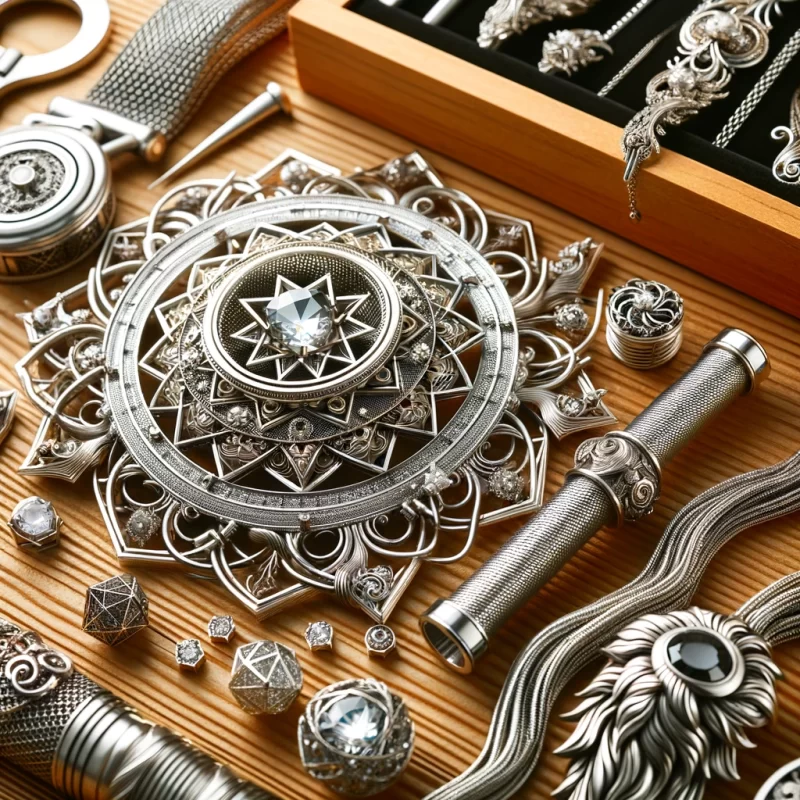
内容目录
Facing the ever-evolving market of stainless steel jewelry, the key to sustaining a business isn’t just in securing a supplier but in nurturing a relationship that fosters both growth and stability. As a seasoned trader with a focus on exporting to the Western markets, understanding how to maintain long-term relationships with suppliers in China is crucial for ensuring a steady supply of innovative and competitively priced products.
Building and maintaining long-term relationships with stainless steel jewelry suppliers is pivotal for business stability and growth. Effective communication, mutual respect, and clear agreements form the cornerstone of these partnerships. By prioritizing these elements, businesses can ensure a reliable supply chain that supports both immediate needs and future expansions.
Continuing to build on this foundation, let’s explore the strategic approaches that enhance supplier relations and ensure that your business remains at the forefront of the jewelry market.
How Do Successful Businesses Cultivate Lasting Relationships with Suppliers?
Creating enduring relationships with stainless steel jewelry suppliers involves more than just regular purchases and transactions. It requires a strategic approach that considers the needs and capabilities of both parties. Here are some key strategies:
- Regular Communication: Keep lines of communication open to discuss new opportunities, address problems, and provide feedback.
- Transparency and Trust: Share important information, anticipate supplier needs, and be transparent about your business goals and expectations.
- Mutual Benefits and Incentives: Develop programs that benefit both parties, such as volume discounts, loyalty programs, or co-marketing efforts.
- Contract Clarity: Ensure that contracts are clear and fair, outlining terms and expectations to avoid misunderstandings.
- Recognition and Respect: Recognize the efforts of your suppliers by providing timely payments and respecting their business culture and practices.
Effective Communication Strategies with Jewelry Suppliers
Effective communication is the lifeblood of any successful supplier relationship. Here’s how you can ensure communication remains a two-way street:
- Regular Updates: Schedule regular meetings to discuss current trends, inventory needs, and market conditions.
- Technological Integration: Use technology to streamline communication, such as ERP systems or cloud-based collaboration tools.
- Cultural Understanding: Be mindful of cultural differences, especially when dealing with suppliers from different backgrounds. Understanding and respecting these differences can prevent potential conflicts and build stronger relationships.
Navigating Challenges in Supplier Relationships
Despite best efforts, challenges may arise in any supplier relationship. Here’s how to navigate these challenges effectively:
- Conflict Resolution: Have a plan in place for resolving disputes. Address issues directly and professionally without delay.
- Adaptability: Be willing to adapt terms and strategies as business needs change and new market opportunities arise.
- Performance Monitoring: Regularly assess the performance of your suppliers against agreed benchmarks and have contingency plans in case of underperformance.
Conclusion
Maintaining long-term relationships with stainless steel jewelry suppliers is not about managing transactions but about fostering partnerships. By prioritizing communication, understanding, and strategic planning, your business can enjoy sustained success and growth in the competitive jewelry market.
Strategic Supplier Engagement
To maintain a prosperous relationship with your stainless steel jewelry suppliers, strategic engagement is key. This involves:
- Supplier Development Programs: Implement programs aimed at helping your suppliers improve their processes and capabilities, which in turn improves the quality of the supplies you receive. For instance, offering training or sharing best practices can help suppliers meet your quality standards consistently.
- Joint Innovation Efforts: Collaborate with your suppliers on product development projects. This partnership can lead to innovative designs and solutions that are mutually beneficial. It fosters a deeper business relationship where both parties are invested in each other’s success.
Leveraging Technology for Enhanced Collaboration
The use of technology can greatly enhance the efficiency and effectiveness of your interactions with suppliers:
- Supply Chain Management Systems: Invest in advanced supply chain management (SCM) systems that provide real-time data to both you and your supplier. These systems help in managing inventory levels, tracking shipments, and forecasting demand more accurately.
- Electronic Data Interchange (EDI): Use EDI to exchange documents with your suppliers electronically, which reduces errors, cuts costs, and speeds up transactions.
- Supplier Portals: Implement a supplier portal that allows suppliers to access purchase orders, submit invoices, and update order statuses online, which enhances transparency and communication.
Building Resilience in Supply Chain Relationships
In a dynamic global market, resilience is key to maintaining long-term supplier relationships:
- Risk Management: Conduct regular risk assessments to identify and mitigate risks associated with your supply chain. This includes diversifying your supplier base to prevent disruptions.
- Contractual Flexibility: Allow for flexibility in contracts to accommodate changes in market conditions or business strategies. This can include clauses for renegotiation or adjustments based on predefined conditions.
- Performance Incentives: Introduce performance-based incentives that reward suppliers for meeting or exceeding their targets. This not only boosts supplier performance but also aligns their goals with yours.
Cultivating a Culture of Continuous Improvement
Continuously working on improving the processes and relationship quality with your suppliers ensures longevity and success:
- Regular Feedback Loops: Establish regular feedback loops where both parties can discuss what is working and what is not. This should be a constructive process aimed at continuous improvement.
- Quality Assurance Meetings: Hold periodic meetings focused on quality assurance where you can discuss issues and implement corrective measures promptly.
- Celebrating Successes: Recognize and celebrate successes together. This could be achieving a major milestone, year-end performance reviews, or simply acknowledging the effort put in by both parties.
Conclusion
Long-term relationships with suppliers are crucial for business stability and success, particularly in industries like stainless steel jewelry manufacturing. By focusing on communication, strategic engagement, technological integration, resilience, and continuous improvement, businesses can cultivate relationships that not only endure but also thrive.
Strategic Adaptation to Market Changes
In the fast-paced world of jewelry manufacturing, adapting strategically to market changes is crucial for maintaining robust supplier relationships:
- Market Trend Analysis: Stay informed about the latest trends in the stainless steel jewelry market. Use this information to discuss potential adjustments in product lines and strategies with your suppliers.
- Flexibility in Order Volumes: Be flexible with order volumes to accommodate changes in market demand. This flexibility can help suppliers manage their production more efficiently and reduce waste.
- Innovation Partnership: Work with suppliers to test and develop new products that can meet changing consumer preferences. This collaborative approach to innovation can lead to shared success and stronger ties.
Shared Growth Opportunities
Creating opportunities for mutual growth can significantly enhance the longevity and quality of your relationships with suppliers:
- Co-development Projects: Engage in projects where both you and your supplier invest resources to co-develop new products. This not only diversifies your offerings but also deepens your business relationship.
- Supplier Upskilling: Invest in training programs for your suppliers to help improve their skills and processes. This could include training in new manufacturing technologies or quality control techniques.
- Access to New Markets: Help your suppliers gain access to new markets through your distribution channels. In return, they might offer exclusive products or pricing.
Fostering a Culture of Mutual Respect
Respect is a fundamental aspect of any successful business relationship. Here’s how you can build a culture of respect with your suppliers:
- Cultural Sensitivity: Understand and respect the cultural practices of your suppliers. This sensitivity can improve communication and interaction, leading to better business relationships.
- Ethical Business Practices: Ensure that all your dealings are conducted ethically and transparently. This builds trust and reliability in your relationships.
- Regular Recognition: Regularly acknowledge the efforts and achievements of your suppliers. Whether it’s through awards, public recognition, or simply verbal appreciation, recognizing their hard work fosters goodwill and loyalty.
Conclusion
Maintaining long-term relationships with stainless steel jewelry suppliers involves a multifaceted approach centered on strategic adaptation, shared growth opportunities, and a culture of mutual respect. By embracing these strategies, businesses can ensure these partnerships not only survive but thrive in a competitive marketplace.
Integrated Supply Chain Strategies
Integrating your supply chain strategies can lead to more streamlined operations and better synchronization between your business and your suppliers:
- Shared Inventory Systems: Implement systems that allow you and your suppliers to view and manage inventory levels in real time. This transparency helps in planning and reduces the risks of overstocking or stockouts.
- Vendor-Managed Inventory (VMI): Consider a VMI system where suppliers manage the inventory of their products at your facilities. This can lead to reductions in carrying costs and improvements in stock replenishment.
- Integrated Planning and Forecasting: Work closely with suppliers to forecast demand and plan production schedules. This collaboration ensures that suppliers are well-prepared for fluctuating demands, leading to fewer disruptions in supply.
Proactive Conflict Resolution
Maintaining a smooth relationship requires addressing conflicts as they arise and establishing mechanisms to prevent them:
- Clear Dispute Resolution Protocols: Have clear protocols in place that outline steps to be taken when disputes arise. This ensures that both parties know how to proceed in a conflict, reducing misunderstandings and promoting a quicker resolution.
- Regular Relationship Audits: Conduct audits of the relationship and business dealings with suppliers to identify potential issues before they escalate. This proactive approach helps maintain transparency and trust.
- Mediation and Arbitration Clauses: Include mediation or arbitration clauses in your contracts to handle disputes neutrally and professionally, avoiding litigation and maintaining good relations.
Reinforcement of Partnership Values
Strong relationships are built on a foundation of shared values and objectives. Reinforcing these values is essential for long-term success:
- Shared Corporate Social Responsibility Goals: Align your business practices with the CSR goals of your suppliers. This could involve joint initiatives on environmental sustainability, ethical sourcing, or community engagement.
- Long-term Strategic Objectives: Align your long-term strategic objectives with those of your suppliers. Regular strategic meetings can help ensure that both parties are moving in the same direction and supporting each other’s long-term goals.
- Commitment to Innovation: Foster an environment that encourages innovation. Encourage suppliers to bring forward new ideas and improvements, and be receptive to these suggestions. This not only drives the industry forward but also strengthens your relationship by building mutual respect and trust.
Conclusion
By integrating supply chain strategies, adopting proactive conflict resolution mechanisms, and reinforcing shared values, businesses can develop robust and enduring relationships with their stainless steel jewelry suppliers. These strategies ensure that both parties can navigate the complexities of the market together, leading to mutual growth and success.



